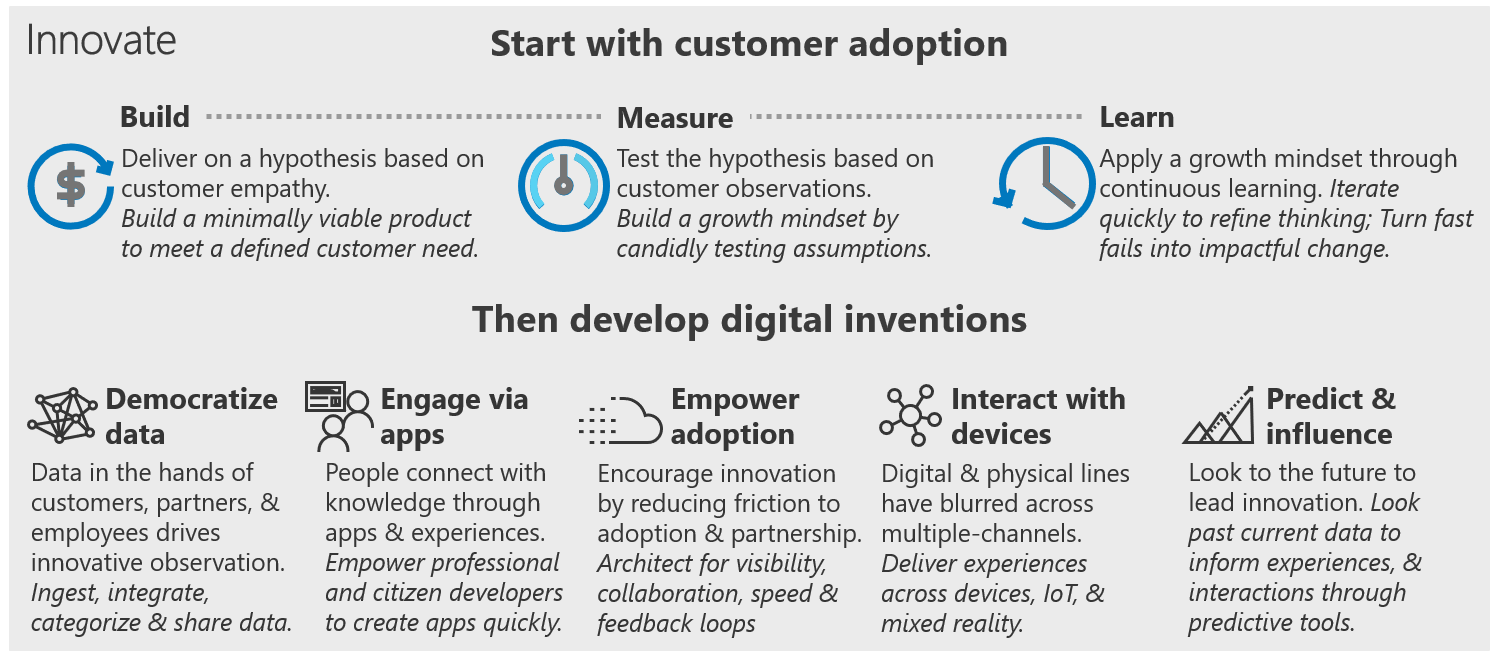Innovation in the digital economy
The digital economy is an undeniable force in almost every industry. During the industrial revolution, gasoline, conveyor belts, and human ingenuity were key resources for promoting market innovation. Product quality, price, and logistics drove markets as companies sought to deliver better products to their customers more quickly. Today's digital economy shifts the way in which customers interact with corporations. The primary forms of capital and market differentiators have all shifted as a result. In the digital economy, customers are less concerned with logistics and more concerned with their overall experience of using a product. This shift arises from direct interaction with technology in our daily lives and from a realization of the value associated with those interactions.
In the Innovate methodology of the Cloud Adoption Framework, we'll focus on understanding customer needs and rapidly building innovations that shape how your customers interact with your products. We'll also illustrate an approach to delivering on the value of a minimum viable product (MVP). Finally, we'll map decisions common to innovation cycles to help you understand how the cloud can unlock innovation and create partnerships with your customers.
Innovate methodology
The simple methodology for cloud innovation within the Cloud Adoption Framework is illustrated in the following image. Subsequent articles in this section will show how to establish core innovation processes, approaches, and mechanisms for finding and driving innovation within your company.

This article series emphasizes the following aspects of this methodology:
- First, always start with customer adoption to generate feedback that builds customer partnerships through the build-measure-learn feedback loop.
- Second, examine approaches to developing digital inventions that prioritize adoption.
The following section describes what innovation is, the formula for innovation, and the commitments required for success with this approach.
Formula for innovation
Innovation is the development and application of ideas that improve the way things are done or what can be achieved.
Successful innovation is not a big-bang transformational event or an elusive magical unicorn. Success in innovation is more of a balancing act, illustrated by a simple equation: innovation = invention + adoption.
Innovation happens at the intersection of invention and adoption. True innovation stems from slowly adjusting human experiences through new approaches, new processes, and new technologies. In this formula, invention means creating a new solution that meets a customer need. Conversely, adoption means applying the new solution to shape human behaviors and interactions. Finding the right balance between invention and adoption requires iteration, data-driven decision making, constant learning, and a growth mindset. It also requires technologies that can keep pace with the countless opportunities to learn in today's digital economy.
The cloud is often a great platform for invention or the technological aspects of innovation. Unfortunately, most great ideas fail during the hard work of adoption, rather than during the creative or invention processes. To ensure success, development teams should always start with adoption as the test for innovation. To use this methodology, the team should agree on these three commitments:
- Commitment to prioritize customers over technology
- Commitment to transparency
- Commitment to iteration
Cultural commitments
Adopting the Innovate methodology requires some cultural commitments to effectively use the metrics outlined in this article. Before you change your approach to driving innovation, make sure the adoption and leadership teams are ready to make these important commitments.
Commitment to prioritize customers over technology
Every development team has a set of tools or technologies that they're most familiar with. It's wise to play to those strengths and use what you know. However, for innovation to be successful, teams must maintain a focus on customer needs and the hypothesis being tested. At times, this focus may not align with the capabilities of a particular tool or architectural approach. To be successful in innovation, the development team must remain open-minded. During the invention process, focus technical decisions on the needs of the customer over the preferences of your team.
Commitment to transparency
To understand measurement in an innovation approach, you must first understand the commitment to transparency. Innovation can only thrive in an environment that adheres to a growth mindset. At the root of a growth mindset is a cultural imperative to learn from experiences. Successful innovation and continuous learning start with a commitment to transparency in measurement. This is a brave commitment for the cloud adoption team. However, that commitment is meaningless if it's not matched by a commitment to preserve transparency within the leadership and cloud strategy teams.
Transparency is important because measuring customer impact doesn't address the question of right or wrong. Nor are impact measurements indicative of the quality of work or the performance of the adoption team. Instead, they represent an opportunity to learn and better meet your customers' needs. Misuse of innovation metrics can stifle that culture. Eventually, such misuse will lead to manipulation of metrics, which in turn causes long-term failure of the invention, the supporting staff, and ultimately the management structure who misused the data. Leaders and contributors alike should avoid using measurements for anything other than an opportunity to learn and improve the MVP solution.
Commitment to iteration
Only one promise rings true across all innovation cycles: you won't get it right on the first try. Measurement helps you understand what adjustments you should make to achieve the desired results. Changes that lead to favorable outcomes stem from iterations of the build-measure-learn process. The cloud adoption team and the cloud strategy team must commit to an iterative mindset before adopting a growth mindset or a build-measure-learn approach.
Next steps
Before building the next great invention, get started with customer adoption by understanding the build-measure-learn feedback loop.
Feedback
Coming soon: Throughout 2024 we will be phasing out GitHub Issues as the feedback mechanism for content and replacing it with a new feedback system. For more information see: https://aka.ms/ContentUserFeedback.
Submit and view feedback for